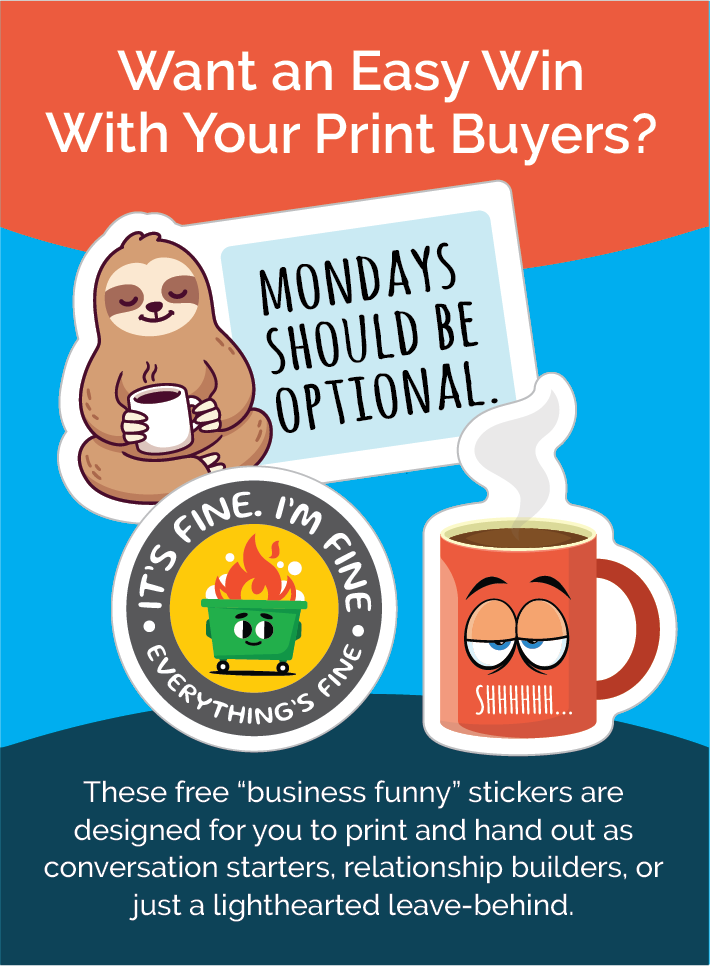Print buyers aren’t comparing paper stocks or binding styles. They’re deciding who they trust to help them get results.
That decision is rarely about logic alone.
Studies on persuasion, like Robert Cialdini’s Influence: The Psychology of Persuasion, show that people make choices based on emotions first, then back them up with facts. For you, as printers, that means your marketing should go beyond listing products and prices. It should connect with the underlying motivations that drive buyers to act.
Here are five proven ways to do that.
1. Encourage Your Print Buyers’ Dreams
Your buyers don’t dream about ink coverage.
They dream about a successful event, more sales, or customers who actually remember them.
If you talk about postcards as “cheap to mail,” you’ll lose them. But if you describe postcards as a way to “get more people through the door,” you’ve aligned with what they actually care about. That’s persuasion 101: connect your product to their aspiration.
In your own campaigns, swap product-driven copy with dream-driven copy. For example, instead of “EDDM postcards starting at $0.15 each,” try “Fill more seats at your next event with a simple, targeted postcard.”
Align your products with outcomes, not specs. Printers who do this consistently move from order-takers to trusted partners.
2. Justify Their Past Failures
Most of your prospects have tried marketing before, sometimes with disappointing results. The danger is that they assume the channel doesn’t work when, really, it was the execution.
This is where empathy becomes a sales tool. In The Art of Persuasion, Burg notes that acknowledging past experiences without blame builds credibility and opens the door for new solutions.
For example, a print buyer might say, “We tried direct mail last year and it didn’t bring anything.” Instead of defending direct mail, respond with: “A lot of campaigns underperform when the list isn’t right. Let’s look at who you targeted.” Suddenly, you’ve turned failure into an opportunity.
Empathy reframes failure as an opportunity and positions you as the solution.

3. Calm Their Fears
Fear is often the unspoken barrier in a sale. Buyers worry: Will this work? Will I waste money? Will my boss think I made a mistake?
Cialdini explains that social proof is one of the most powerful antidotes to fear. Show what’s worked for others like them with case studies, testimonials, or even a quick story.
For you, this might sound like:
- “One of our nonprofit clients grew donations 28% with this exact appeal letter.”
- “Another business mailed just 500 pieces and saw 42 new customers in one month.”
When you address fear head-on, you don’t just sell a brochure; you sell peace of mind.
4. Confirm Their Suspicions
Buyers and print buyers alike are naturally skeptical.
They’ve been burned by marketing that overpromised and underdelivered. One of the best things you can do is agree with their suspicion, and then distinguish yourself.
For example: “You’re right, a lot of marketing does end up ignored. But that’s why combining direct mail with email follow-up changes the response rate.”
Or: “You’re right; many online ads never even get noticed. But a postcard in the mailbox guarantees your message is seen, and when paired with digital ads, it reinforces the impact.”
By validating what buyers already suspect, you prove you’re honest and then show how your solutions stand apart.
Confirming suspicion builds trust. You’re not pretending their doubts don’t exist. You’re showing you understand them and have a plan to counter them.

5. Help Them Identify Their Enemies
People are motivated when they feel like they’re fighting against something.
In marketing, that “enemy” isn’t another person; it’s the challenges that hold them back: wasted budgets, shrinking attention spans, competitors stealing their customers.
Help your print buyers see you as their ally in the fight. Frame your print solutions as the weapons that beat invisibility and win attention. For example:
- “Your competition is already showing up in mailboxes. If you stay silent, they win by default.”
- “Relying on digital alone means you’re fighting for scraps in a crowded inbox. Print gives you a channel they can’t ignore.”
This shift, making buyers the hero and positioning your services as their strategy, changes the whole tone of the conversation.
Putting It All Together
Psychology isn’t fluff; it’s the foundation of influence.
When you encourage dreams, justify failures, calm fears, confirm suspicions, and point out enemies, you’re not just selling ink on paper. You’re giving buyers confidence and clarity in their decisions.
That’s what builds long-term loyalty.
If you’d like to see how we weave these principles into ready-to-use website, direct mail, email marketing, and social marketing solutions for printers, ask us about a free marketing audit.
Every blog, email, and mailer is written with these psychological triggers in mind, so you can focus on running your shop while still marketing like a pro.



